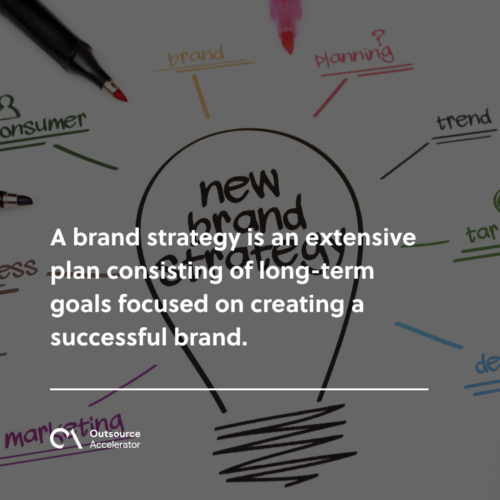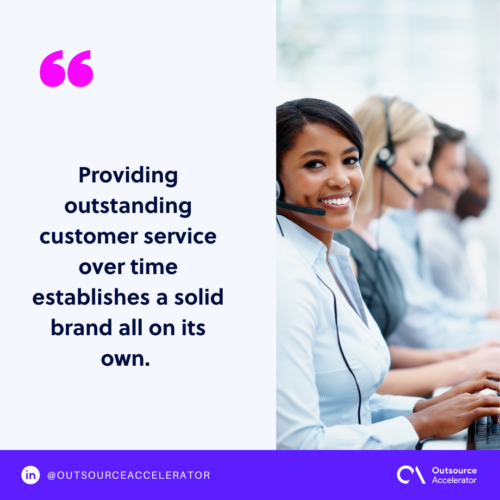10 types of brand strategy that will help your business succeed

A lack of a clear brand strategy often results in a diluted and inconsistent brand image, making it challenging to establish a strong and memorable identity in the minds of consumers.
This can lead to decreased brand loyalty, confusion among target audiences, and difficulties in effectively communicating the unique value proposition of a product or service.
Businesses may struggle to differentiate themselves from competitors and may find it hard to build a lasting and impactful presence in the market.
This article highlights the critical role that a strategic approach to branding plays in shaping the success and perception of a business.
What is a brand strategy?
A brand strategy is an extensive plan consisting of long-term goals focused on creating a successful brand. The ultimate goal is to establish a brand that is unique, familiar, and impactful to consumers.
Companies develop a branding strategy to help establish the kind of image they wish to project to their customers. Purpose, consistency, emotion, and employee engagement are all important aspects of a marketing plan.

Why are branding strategies important?
An integrated branding strategy aids in better communication with your customers. The right brand strategy leads to increased brand recognition, which attracts new customers and retains current ones.
Not only that but creating a branding strategy also puts you ahead of your competitors. Your company develops a strong brand identity that makes you stand out.
If you are a new, up-and-coming business, you will benefit from utilizing different branding strategies to help enhance brand awareness and get your name on the map.
If you want your brand to be recognized and preferred by customers, you’ll need a solid branding strategy to help you get there.
10 types of brand strategy that lead to success
It takes time and effort to establish a memorable brand image in the eyes of your target market. Here are different types of branding strategies that can be helpful to your business.
1. Product branding
Every recognizable brand has a logo or design attached to it, which is one of the key elements of an effective brand strategy.
Branding a product involves many different factors, but the most important are logos, designs, names, descriptions, packaging, and messages that go with them. All of these elements work together to elicit an emotional response from customers and help create a brand identity.
A good product brand is aware of its target audience, their needs, wants, and concerns, as well as the competition. These factors impact products and brand strategies.
2. Personal branding
Personal branding is about creating an identity with a unique selling point. Some key elements to personal branding include having a distinct look, brand story, and message.
An important part of building your personal brand is becoming known to your target audience. It necessitates articulating your principles, values, objectives, and mission clearly and concisely.
Athletes and politicians are examples of successful personal branding because of their high visibility on social media platforms. Establishing this kind of personal brand is linked to fame and notoriety.
Many successful entrepreneurs have used personal branding to rise to fame. Some businesses find it easier to acquire momentum with a robust social media presence that produces leads and cultivates a following.
3. Attitude Branding
Using attitude branding is a type of branding strategy that can get your target audience to connect your brand with a more general feeling.
Instead of encouraging consumers to associate your brand negatively with their self-expression and identity, it’s about creating good feelings and emotions that go beyond a specific product.
Occasionally, a firm will use a generalized emotion or attitude to promote its goods and portray its operations.
With this branding approach, the company is able to liven up by selling a more general sentiment to establish an emotional connection with its clients.
4. Corporate branding
The purpose of corporate branding is to describe a company in its entirety. Corporate strategy, commercial activity, and brand stylistics all work together to produce a unified brand identity.
Consumers can better identify various product offerings over time because of corporate branding.
Because consumers already know a product’s quality, reliability, and purpose, effective corporate branding reduces the need for huge marketing initiatives for every new product.
Additionally, a good corporate branding strategy allows you to connect with new and existing customers and differentiates your brand from others.
5. Service branding
By shifting their focus from manufacturing items to providing end-to-end solutions and intangible services, firms can build up a service brand.
Service branding is not just about selling a product; it is about providing excellent customer service. It includes both the online and offline experiences you deliver for your customers.
Providing exceptional customer service over time is already a solid service branding strategy on its own, which increases brand loyalty in the process. Customers are less likely to leave because of dissatisfaction with the product, which means faster growth.
Due to the current climate, firms are attempting to reach this goal through omnichannel marketing, which is gaining popularity in the business world.

6. Online branding or internet branding
Businesses nowadays are migrating to the online scene, leading them to come up with new branding strategies for their target audience more easily.
This is where online branding (a.k.a internet branding) comes in. An internet brand uses online platforms such as social media and ecommerce platforms as a more digital approach to marketing.
This type of brand strategy has become increasingly vital in the rapidly evolving digital world.
The goal of marketing technologies is to make the process easier while also measuring the impact of various marketing methods.
7. Private-label branding
Private label and store brands are created and sold exclusively for a single merchant in order to compete with well-known brand names. They do not sell, advertise, or brand their own products.
Products sold under a retailer’s private label (sometimes known as an “own brand label”) are made by a third party but packaged by the retailer.
Tesco, for example, sells generic brand names like Heinz baked beans, as well as its own branded baked beans called “Tesco Value.” While a company is not selling its own products directly, it still helps with gaining brand recognition.
8. No-brand branding
Also called “minimalist branding,” no-brand branding is when the product is strong enough to catch your customer’s attention on its own without the help of any additional features or marketing tactics.
The “no-brand” strategy is effectively implemented by several companies through the use of packaging that imitates the simplicity of generic brand names.
Since the lack of a brand name draws attention to the product, “no-brand” branding can be considered a form of establishing brand identity.
For instance, brandless implies quality food at a low price and shows that consumers do not have to pay more than required for branded food by following the same method. With healthy and economical meals, the quality speaks for itself.
9. Geographic branding
Geographic branding refers to nation-building and the role that marketing a country plays in boosting small companies in the area.
Additionally, businesses use geographic branding to entice people to travel to or invest in a particular region. Towns, cities, and even entire countries take this approach to highlight what makes them special.
Ambassadors of specific countries or towns and tourism companies utilize geographic branding to create a strong brand identity.
10. Retail branding
Using retail branding as a strategy means taking a brand’s idea and applying it to a retail business.
Many merchants provide the same goods made by a number of different companies. Retail branding allows businesses to stand out by creating a distinct brand for their products.
Retail branding is commonly seen in store chains that deal their products directly to consumers. All outlets are critical in sustaining the brand’s identity because they are where most customers first come in contact with the company.
How to build a brand strategy
Creating a branding strategy is a great way to connect your business with new customers. Here are some easy steps to start your own brand strategy planning:
Understand your brand
You cannot create a branding strategy if you do not know what your brand is.
Examine your present branding and marketing efforts and make necessary adjustments. First, it is important that you have deep knowledge about your company’s purpose, vision, mission, and core values.
- Purpose. The purpose of a company is a strong declaration of why it is in business.
- Vision. This speaks of where you want your company to go in the future.
- Mission. A mission statement outlines the purpose and general goal of a company. The vision is supported by the mission statement.
- Core values. The views, philosophies, and concepts that guide your firm are considered to be your company values.
Create user personas
A buyer persona is a representation of a potential consumer. It includes demographics and depicts a genuine person, including what they go through in a day, their likes and dislikes, and the social networking platforms they utilize.
Buyer personas ensure that all operations related to acquiring and serving clients are matched to the specific needs of the target market.
Developing buyer personas and using them to manage your organization can help you stay focused on your consumers’ demands and allow you to cater your branding strategies to your target audience.

Make a list of your competitors and research them
Knowing what your competitors are up to can help you establish your product’s unique value proposition and what sets it apart from the competition.
This informs your future marketing efforts and allows you to see what your opponent is doing properly. By understanding your competitors, you can come up with ways to improve your personal brand.
A successful brand strategy involves doing something that other brands are not, which helps you stand out from the competition.
Create a unique brand identity
Brand identity not only makes your goods more memorable but also establishes your brand’s authority in the marketplace.
Consistent brand messaging and maintaining a solid identity give you an advantage over competitors and lead to increased credibility and trust.
It’s important to understand where your firm stands with current and potential customers. From the perspective of your customers, brand positioning refers to how your firm compares to its competitors.
Execute your website
Creating a company website is a big part of your branding strategy. Being able to provide your target customers with detailed information about your organization via a well-designed website qualifies as free marketing.
Keep the best website practices in mind when creating a wonderful branded website. Using high-quality photographs, keeping the design simple, and making your website mobile-friendly are all part of this strategy.
Not only is it easier for your customers, but it guides your overall online branding strategy. Some of the biggest powerhouse brands use websites to do all the talking for them, from mentioning their brand values to why customers should choose them over others.
Monitor your website and brand strategy
Executing your branding strategy is not the final step; perhaps the most important part is monitoring the results.
If you watch your brand, you’ll be able to see when and how people talk about your business. From there, you can determine what you’re doing well and incorrectly and make adjustments as necessary.
You must have consistent branding and a positive and enduring brand reputation if you want to succeed in business.
Create a branding strategy now
Regardless of which of the types of branding strategies you decide to use, it could make a huge difference in consumer perception and how your brand stands out from the rest.
With so many branding strategies to utilize, it is best to choose one that works best for your parent company.
No matter how good your product or service is, it will not matter unless it is paired with the right branding strategy.







 Independent
Independent




